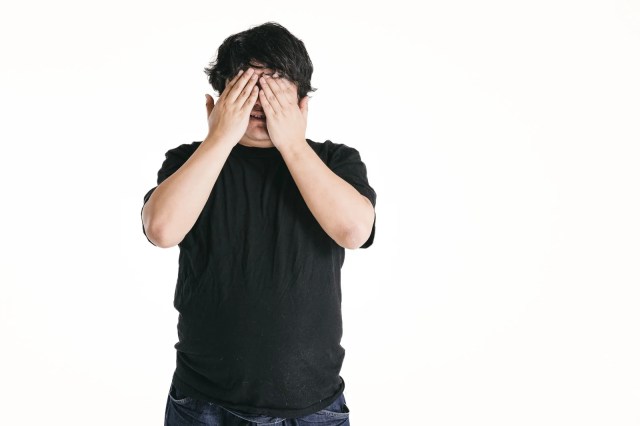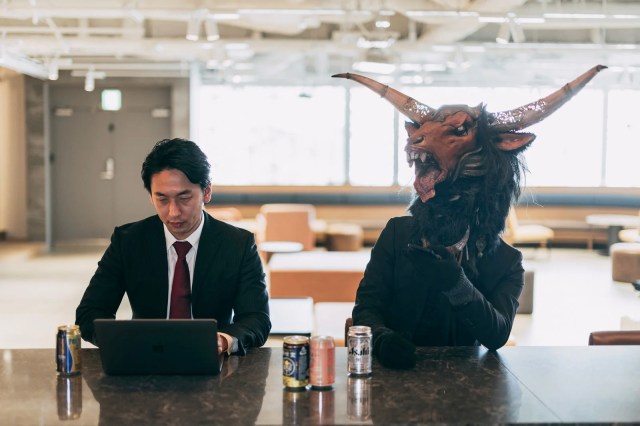
I’m going to lend the video to someone within a week anyway… just in case.
Japan is home to all kinds of festivals from snow festivals and lantern festivals to fight festivals and naked festivals. But none of them are quite like the Sleeping Festival (Nematsuri) in Taharashi City, Aichi Prefecture… At least, I assume that’s the case because hardly anyone has ever seen it to know for sure.
The oldest record of this Sleeping Festival is from 1707 but even back then it was stated that the origin of the festival is unknown, making it potentially much older. The rituals involved have changed somewhat over the centuries but essentially consist of Shinto priests and/or others carrying something between Kobe Omiyashinmeisha Shrine and Hisamaru Shrine on certain days that correspond to the Lunar New Year. In its current form, a procession of about 10 people carries a sacred object in a box from Hisamaru to Omiyashinmeisha and then back again.
▼ The shrines are only about 550 meters (0.3 miles) apart but the procession takes about half an hour to make a one-way journey.
There are also rituals held when the object leaves Hisamaru, arrives at Omiyashinmeisha, leaves Omiyashinmeisha the next day, and returns to Hisamaru, as well as a final ritual to confirm the successful movement of the object. However, none of this should be seen by anyone and that is one detail of the Sleeping Festival that has hardly changed for centuries.
In fact, the reason it’s called the Sleeping Festival is that when it’s happening, everyone stays home and keeps their doors and windows shut, so it appears as if everyone is sleeping. The shrines even put up signs during the time of the festival to warn everyone not to come near the premises or even look in its general direction. This is because it is said anyone who sets their eyes on this festival will meet with serious misfortune.
▼ “Hi! Name’s misfortune. Seriously nice to meet ya!”
A few decades ago an elementary school principal went to visit his friend who was a priest during the Sleeping Festival and suffered a stroke which required a year to recover from. In 1929, a man building a smokestack for a factory looked down and saw the Slumber Festival, mocking it and the gods for not striking him down then and there. The next day he fell to his death. In the 1930s, a Korean person who was unfamiliar with the festival saw it while hanging some laundry out to dry. They then developed a fever which they recovered from only after an exorcism was performed.
It was also said that during the Meiji Restoration, when traditional Japanese customs were falling out of favor to more modern Western trends, the viewing restriction was lifted. However, after someone who saw the festival died, they strictly enforced it once again.
Granted, these anecdotes all have a very urban-legend vibe to them, but people still take it quite seriously. Teachers tell kids not to go out when its happening and most of the locals have never seen the Sleeping Festival for their entire lives. Accidents do happen from time to time, however, so a special forgiveness ceremony is held afterward for those who happened to have caught a glimpse of it to reset their luck.
Now that everyone’s up to speed on the Sleeping Festival and the dangers that simply setting your eyes on it might hold, let’s all take a look at it! For the first time ever, the shrines have allowed a TV crew to film the festival.
▼ The festival itself can be seen about two minutes into the segment.
According to the organizers, only looking at the real thing in person is bad luck, and watching a video doesn’t hold the same accursed potential. The reason that they wanted their forbidden-to-view festival to finally be viewed is that its future is in jeopardy. Turns out, when you forbid everyone from seeing your festival and no one knows what goes on in it, it’s really hard to find new people to carry it on. This begs the question, why even bother carrying on a festival that brings bad luck to people?
Although the exact origins of the festival itself are unclear, it is known to be based on the story of Prince Hisamura who was forced to flee a major civil war during the 14th century. He ended up in this area and was taken in by the local nobility and townsfolk. He spent the rest of his days dressed as a woman to avoid capture, and his skin was afflicted with a purple rash by whatever he used to make it look whiter.
His appearance was so sad that when he took his daily walks around Omiyashinmeisha the townsfolk averted their eyes out of pity. It could also be said that looking at him was bad luck in that whoever did might be accused of harboring a fugitive and face the penalty should the prince ever be discovered.
▼ The story of Prince Hisamaru and the Sleeping Festival, which unfortunately is only in Japanese.
So, in that way, the Sleeping Festival serves as a reminder of the community’s ability to band together and help someone out in need. And while its future might be in danger now, they’ve somehow managed to keep it going this way for longer than anyone knows, so perhaps they can find a way.
I’d personally recommend they get some of those avatar robots that work at Family Mart to carry the sacred objects and let people help via VR or remote control. That way the tradition can continue and no one has to look directly at it ever again!
Sources: TBS News Dig, Kobe City Minkan
Featured image: Pakutaso
Insert image: Pakutaso
● Want to hear about SoraNews24’s latest articles as soon as they’re published? Follow us on Facebook and Twitter!


 Fights break out at Japanese fight festival
Fights break out at Japanese fight festival Akutai Matsuri: Japan’s Verbal Abuse Festival, where insults and bad behaviour are encouraged
Akutai Matsuri: Japan’s Verbal Abuse Festival, where insults and bad behaviour are encouraged Hanazono Jinja Shrine: Lanterns, stalls and rakes at annual Tori no Ichi cock festival in Tokyo
Hanazono Jinja Shrine: Lanterns, stalls and rakes at annual Tori no Ichi cock festival in Tokyo Japanese miko shrine maidens turn into off-road racing queens in new commercial 【Video】
Japanese miko shrine maidens turn into off-road racing queens in new commercial 【Video】 Our Japanese language reporter P.K. offers a spooky tale, advice to protect yourself from spirits
Our Japanese language reporter P.K. offers a spooky tale, advice to protect yourself from spirits Japan’s new difficult-to-drink-from beer glass protects your liver, but it’s a brutal experience
Japan’s new difficult-to-drink-from beer glass protects your liver, but it’s a brutal experience Hello, cosmetics! Clinique teams up with Hello Kitty this summer for first-time collaboration
Hello, cosmetics! Clinique teams up with Hello Kitty this summer for first-time collaboration How to order snacks on a Shinkansen bullet train in Japan
How to order snacks on a Shinkansen bullet train in Japan Demon Slayer: Kimetsu no Yaiba gets new roller coaster attractions and food at Universal Studios Japan
Demon Slayer: Kimetsu no Yaiba gets new roller coaster attractions and food at Universal Studios Japan New samurai glasses are Japan’s latest weird must-have souvenir
New samurai glasses are Japan’s latest weird must-have souvenir Burger King Japan suddenly adds Dr. Pepper and Dr. Pepper floats to its menu nationwide
Burger King Japan suddenly adds Dr. Pepper and Dr. Pepper floats to its menu nationwide New Nintendo Lego kit is a beautiful piece of moving pixel art of Mario and Yoshi【Photos】
New Nintendo Lego kit is a beautiful piece of moving pixel art of Mario and Yoshi【Photos】 What do you eat when you catch a cold? We asked 11 of our Japanese reporters
What do you eat when you catch a cold? We asked 11 of our Japanese reporters High-fashion Totoro cuddle purse is like an elegant stroll in the forest【Photos】
High-fashion Totoro cuddle purse is like an elegant stroll in the forest【Photos】 Why Japanese doesn’t need swear words
Why Japanese doesn’t need swear words Nintendo history you can feel – Super NES, N64, and GameCube controllers become capsule toys
Nintendo history you can feel – Super NES, N64, and GameCube controllers become capsule toys “The most Delicious Cup Noodle in history” – Japan’s French Cup Noodle wins our heart【Taste test】
“The most Delicious Cup Noodle in history” – Japan’s French Cup Noodle wins our heart【Taste test】 Starbucks releases a cute Frappuccino and Unicorn Cake…but not in Japan
Starbucks releases a cute Frappuccino and Unicorn Cake…but not in Japan Kyoto Tower mascot termination reveals dark side behind cute Japanese characters
Kyoto Tower mascot termination reveals dark side behind cute Japanese characters McDonald’s Japan’s Soft Twist Tower: A phantom ice cream only sold at select branches
McDonald’s Japan’s Soft Twist Tower: A phantom ice cream only sold at select branches Yabai Ramen: What makes this Japanese ramen so dangerous?
Yabai Ramen: What makes this Japanese ramen so dangerous? Finally! Nintendo Japan expands Switch 8-bit controller sales to everybody, Online member or not
Finally! Nintendo Japan expands Switch 8-bit controller sales to everybody, Online member or not Japanese government wants to build luxury resorts in all national parks for foreign tourists
Japanese government wants to build luxury resorts in all national parks for foreign tourists To combat declining birth rate, Japan to begin offering “Breeding Visas” to foreigners
To combat declining birth rate, Japan to begin offering “Breeding Visas” to foreigners 10 things you should buy at 7-Eleven in Japan
10 things you should buy at 7-Eleven in Japan Studio Ghibli releases anime heroine cosplay dresses that are super comfy to wear
Studio Ghibli releases anime heroine cosplay dresses that are super comfy to wear Woman charged for driving suitcase without a license in Osaka
Woman charged for driving suitcase without a license in Osaka Studio Ghibli unveils My Neighbour Totoro miniature house model
Studio Ghibli unveils My Neighbour Totoro miniature house model Kyoto experiencing problems with foreign tourists not paying for bus fares, but not on purpose
Kyoto experiencing problems with foreign tourists not paying for bus fares, but not on purpose Fighting mild hunger with a Japanese soda that turns into jelly in the stomach【Taste test】
Fighting mild hunger with a Japanese soda that turns into jelly in the stomach【Taste test】 Studio Ghibli’s Howl’s Moving Castle tapestry unveiled in Japan for first time
Studio Ghibli’s Howl’s Moving Castle tapestry unveiled in Japan for first time McDonald’s new Happy Meals offer up cute and practical Sanrio lifestyle goods
McDonald’s new Happy Meals offer up cute and practical Sanrio lifestyle goods Sales of Japan’s most convenient train ticket/shopping payment cards suspended indefinitely
Sales of Japan’s most convenient train ticket/shopping payment cards suspended indefinitely Sold-out Studio Ghibli desktop humidifiers are back so Totoro can help you through the dry season
Sold-out Studio Ghibli desktop humidifiers are back so Totoro can help you through the dry season Japanese government to make first change to romanization spelling rules since the 1950s
Japanese government to make first change to romanization spelling rules since the 1950s Foreigner’s request for help in Tokyo makes us sad for the state of society
Foreigner’s request for help in Tokyo makes us sad for the state of society Ghibli founders Toshio Suzuki and Hayao Miyazaki contribute to Japanese whisky Totoro label design
Ghibli founders Toshio Suzuki and Hayao Miyazaki contribute to Japanese whisky Totoro label design Doraemon found buried at sea as scene from 1993 anime becomes real life【Photos】
Doraemon found buried at sea as scene from 1993 anime becomes real life【Photos】 Tokyo’s most famous Starbucks is closed
Tokyo’s most famous Starbucks is closed Princesses, fruits, and blacksmiths: Study reveals the 30 most unusual family names in Japan
Princesses, fruits, and blacksmiths: Study reveals the 30 most unusual family names in Japan Japanese Penis Festival shrine distances itself from penis mascot
Japanese Penis Festival shrine distances itself from penis mascot Step into a magical spirit world at the Motomiya Festival at Fushimi Inari Shrine in Kyoto
Step into a magical spirit world at the Motomiya Festival at Fushimi Inari Shrine in Kyoto Osaka shrine’s sacred horse provides no bathroom privacy, lots of laughs after “remodeling”【Vid】
Osaka shrine’s sacred horse provides no bathroom privacy, lots of laughs after “remodeling”【Vid】 Students at Tokyo University of the Arts create amazing festival shrines of giant monsters 【Pics】
Students at Tokyo University of the Arts create amazing festival shrines of giant monsters 【Pics】 Japanese shrine maidens in Osaka spotted wearing unusual costumes during winter
Japanese shrine maidens in Osaka spotted wearing unusual costumes during winter Nagasaki Lantern Festival: An awesome event that will whisk you away into a celestial world【Pics】
Nagasaki Lantern Festival: An awesome event that will whisk you away into a celestial world【Pics】 Miyako-jima’s Paantu Festival: Traumatizing small children to bring them good luck
Miyako-jima’s Paantu Festival: Traumatizing small children to bring them good luck Shimotsuki Matsuri: The extraordinary winter festival that inspired Ghibli’s ‘Spirited Away’
Shimotsuki Matsuri: The extraordinary winter festival that inspired Ghibli’s ‘Spirited Away’ A visit to one of Japan’s motorcycle Shinto shrines
A visit to one of Japan’s motorcycle Shinto shrines Visiting Asagaya Tanabata Festival, known for its spectacular displays that never fail to surprise
Visiting Asagaya Tanabata Festival, known for its spectacular displays that never fail to surprise Host your very own Japanese summer festival with these DIY carnival game stands
Host your very own Japanese summer festival with these DIY carnival game stands Mystery Tourist Spot: Merlions in Japan?
Mystery Tourist Spot: Merlions in Japan? Watch the “world’s largest firework” go off 【Video】
Watch the “world’s largest firework” go off 【Video】 Shinto shrine naked festival ritual asks men to cover up for first time in three-century history
Shinto shrine naked festival ritual asks men to cover up for first time in three-century history Sumida River Fireworks Festival aftermath: Not everyone in Japan has perfect manners after all
Sumida River Fireworks Festival aftermath: Not everyone in Japan has perfect manners after all
Leave a Reply